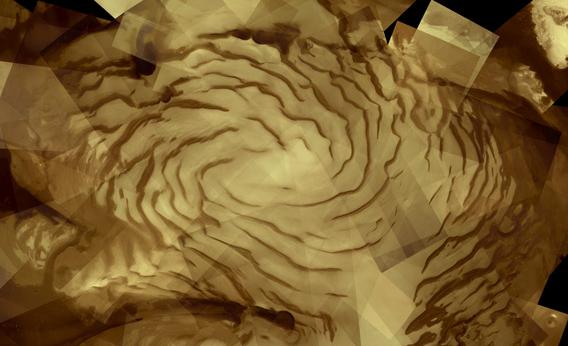Create a free profile to get unlimited access to exclusive videos, sweepstakes, and more!
Top of Another World to Ya!

On June 2, 2003, the European Space Agency launched the Mars Express probe to the red planet. It arrived later that year, entering orbit and starting its mission to study the Martian climate, atmosphere, and geology and to look for signs of water on the surface.
Although the attempt to set the lander Beagle 2 on the surface resulted in the lander's loss, the orbiter has been far more successful. To celebrate the 10th anniversary of launch, the ESA released this devastating picture of the north polar ice cap of Mars:
You really want to click that picture to embiggen it. Itâs lovelyâa mosaic of 57 separate pictures, enough to cover the 1,000-kilometer-wide (600-mile-wide) ice cap.
The ice there is mostly water ice, permanently frozen. However, thereâs a thin layer of frozen carbon dioxideâdry iceâthat coats it every winter and sublimates (turns directly from a solid into a gas) every summer. That means the ice cap changes all the time, making it a target of study.
Iâm fascinated by the swirls in the ice. The Martian atmosphere is thin, only about 1 percent as thick as Earthâs, but itâs enough to carry dust aloft and to erode features into the surface. The spiral pattern is most likely the result of those prevailing winds. Amazingly, over long periods of time, those spiral arms move, rotating around the pole, like the arms of a pinwheel (or a galaxy). Oddly, the arms move in the opposite direction of the wind. As the wind blows down the warmer, sunward-facing side of a trough, it picks up water vapor and ice. When it blows across the other side, which is colder, it deposits that water as ice. So the wind erodes the ice in the upwind direction and deposits it downwind. Over time, that means the ice appears to migrate in the opposite direction the wind blows.
Thatâs pretty wild. Mars is a surprising place, with dust devils, avalanches, ancient lake beds, and now counter-rotating aeolian-carved boreal icy spiral arms. It never ceases to amaze me.
Congratulations to the Mars Express team for their anniversary! May we continue to explore our local worlds for many, many more years.


























